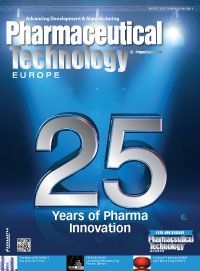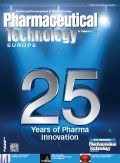Advances in the Pharmaceutical Industry Have Shaped Particle Sizing Technology
Pharmaceutical Technology Europe
A diverse range of particle sizing solutions is available, from techniques for the characterization of complex formulations through to online PAT tools for real-time measurement.

From QC to QbD and Beyond
Analytical technologies and bio/pharmaceutical process developmenthave advanced in parallel through necessity and innovation.
The pharmaceutical industry is an exacting consumer of analytical technology, requiring techniques that deliver the data required to enable a knowledge-based approach to product development and to manage the risk of transfer of new products into manufacturing. The adoption of quality by design (QbD) and process analytical technology (PAT) has encouraged the pharmaceutical industry to embrace and exploit new analytical approaches.
The importance of particle size information throughout the pharmaceutical lifecycle means that the evolution of particle sizing techniques has closely tracked these advances. Today, a diverse range of particle sizing solutions is available, from techniques for the characterisation of complex formulations through to online PAT tools for real-time measurement.
QbD is based on the principle that consistent product quality can be better achieved through complete product and process understanding, rather than through fixed point sequential or end-stage quality control (QC). Simplifying the application of QbD has been a primary driver for analytical instrumentation developers. More generally, the bigger trend has been to adapt and develop technology to deliver more detailed information or to provide the same information in a more timely way.

Pharmaceutical Technology Europe25th Anniversary Issue
The advancement of particle size analysis
Laser diffraction particle sizing is a good example of an analytical technique that has successfully matured from specialist R&D procedure to a routine QC task, and then to online implementation.
Advances in software and hardware design have enabled the optimisation of laser diffraction instrumentation for the laboratory to the point where particle size measurements over a size range encompassing most pharmaceutical actives, excipients and intermediates can be achieved in under a minute. Smart software and analysis capabilities ease the burden of method development, validation and transfer.
PAT, in the form of in-line laser diffraction particle sizing systems, enable real time data capture at a speed that is sufficiently fast to track even rapidly changing processes and open up a route to automated monitoring and/or control at the commercial scale. The application of full process automation for particle size control is, as yet, in its infancy within the pharmaceutical industry, but this shaping of laser diffraction for optimal application at every stage of the pharmaceutical lifecycle provides a powerful example of the symbiosis between the pharmaceutical and analytical instrumentation industries.
While the past few decades have seen laser diffraction mature in its application, there has been a time of rapid innovation in the other areas of particle characterisation. The commercial availability of automated imaging systems has substantially reduced the time taken to obtain statistically relevant particle shape information. Automated imaging has been successfully combined with spectroscopy to deliver component-specific particulate data. Techniques such as morphologically directed Raman spectroscopy enable the measurement of the particle size and shape of discrete chemical entities within multicomponent formulations. These capabilities are now being applied to better understand blending processes, and also to support the demonstration of bioequivalence within generic-drug applications.
The future of pharmaceutical analysis
New challenges likely to shape both the analytical instrumentation and pharmaceutical industries include the adoption of QbD principles in the development of robust analytical methods. The success of analytical QbD (AQbD) will depend on instrumentation providers developing tools that allow operators to rapidly explore the operating region for an analysis, to ensure robust and reliable data are achieved every time.
A progressive shift towards biopharmaceuticals, as opposed to small molecule drugs brings new, unique challenges in terms of developing the analytical technology needed to generate appropriate biophysical and biochemical data during pre-formulation, formulation and QC testing of these products.
Into the future, mutually beneficial collaboration between the pharmaceutical and analytical instrumentation industries looks certain to continue, to ensure new challenges are efficiently met. By sharing information with analytical technology providers, the pharmaceutical industry will prompt the agile development approaches required to commercialize new analytical techniques that fully meet its evolving needs.
About the Authors
Paul Davies is global business manager and Paul Kippax is pharmaceutical portfolio manager, both for Malvern Instruments.

Drug Solutions Podcast: Applying Appropriate Analytics to Drug Development
March 26th 2024In this episode of the Drug Solutions Podcast, Jan Bekker, Vice President of Business Development, Commercial and Technical Operations at BioCina, discusses the latest analytical tools and their applications in the drug development market.
Full Tolerance Coverage Method for Assessing Uniformity of Dosage Units with Large Sample Sizes
March 10th 2025The ‘full tolerance coverage method’ is introduced as a coverage estimation approach for assessing the uniformity of dosage units from large sample sizes, ensuring that no dosage unit exceeds the specification range.
Inspiration Over Desperation: Accurant Biotech CEO Talks Leadership, Innovation, and Motivation
March 4th 2025Xiao-Yan Cai, PhD, shares insights into her leadership style, the importance of motivation in the workplace, and how she balances repetition with innovation, discussing how hobbies and resilience uniquely shape her professional approach, emphasizing the value of perseverance and preparation in both science and life.